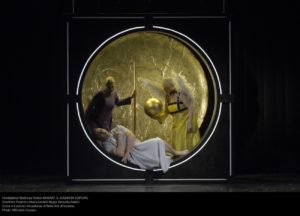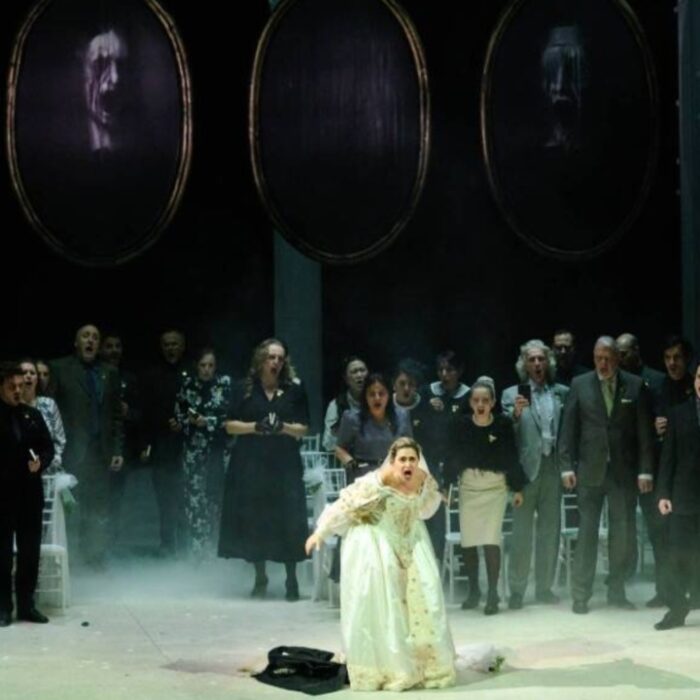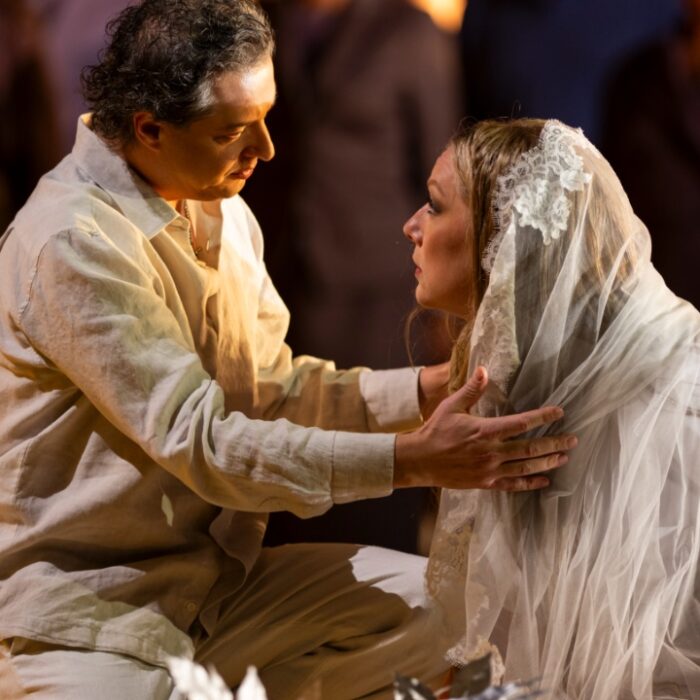
Teatro La Fenice 2018-19 Review: Il Sogno di Scipione
By Alan NeilsonOriginally “Il Sogno di Scipione” was written as a celebratory work for the Archbishop Schrattenbach of Salzburg in 1771, who was unfortunate enough to die before its first performance. Mozart, therefore, took the opportunity to add a new extended final aria and rededicate the work to his successor, Hieronymus Colloredo, which was then performed at his investiture the following year.
The opera, or more correctly the serenata, was then neglected for over 200 years and did not receive a staged revival until 1984, in a production at Vicenza’s Teatro Olimpico. La Fenice’s decision to stage the work, in conjunction with Venice’s Academy of Fine Arts, whose students under the tutelage of Elena Barbalich were responsible for the staging, therefore, came as a rare and welcome opportunity to see one of Mozart’s lesser-known works.
The Historic & Poetic Scipione
Scipione is famous for being the Roman general who defeated Carthage during the Third Punic War, and who then burned the city to the ground and salted the earth, so that it could not re-emerge as future threat to Rome. Although coming from a military background, his adoptive grandfather was also a successful general responsible for defeating Hannibal in the Second Punic War, Scipione had an interest in philosophy and poetry, and was also to find fame in Cicero’s text “Scipio’s Dream,” in which he was used as a model for a discussion on the qualities needed to make a good king.
It is this text which Metastasio used as a basis for his libretto, which was in turn was used by Mozart for his serenata. The actual narrative is fairly static: Scipione falls asleep, and is approached by Constancy and Fortune, who demand he must choose between them. Fortune promises him power, fame and riches, but admits that she is impatient and can easily change her mind. Constancy explains that it is only her strength that can withstand Fortune’s fickle nature. During the dream his adoptive grandfather, Scipio Africanus, and his father, Emilio, also appear in order to advise Scipione. Finally, he chooses Constancy over Fortune, and thus upholds the values of good kingship and wise governance which, in theory at least, underpinned the absolute monarchies, which prevailed in pre-revolutionary Europe in the 18th century.
The Challenges & Approach
One of the problems of staging a production of “Il Sogno di Scipione” is the lack movement, very little happens, and turning it into a piece of engaging theatre can be problematic.
It was, however, a concern which Barbalich was clearly keen to address. Her starting point was to expose the differences between Cicero’s narrative and Metastasio’s libretto, noting that the latter veered away from Cicero’s detailed consideration of the Platonic and Pythagorean arguments, being instead more a celebration of power.
Moreover, she married this to the actions of the historical Scipione, who was clearly a brutal soldier, unafraid to exercise his power as he deemed fit. She therefore decided to make power itself the focal point for this production.
All the protagonists, with the exception of Scipione, but including the goddesses, Constanza and Fortuna conspire to elevate Scipione to a position of power, for it is what the masses need. Scipione, is taken in by the charade, and believes it to be his destiny, which he can see in the harmony of the spheres. It is, of course, all a baroque pretense.
By the end of the opera Scipione has been hollowed out, the crowd dress him in the clothes of the powerful, but have no interest in him as a person, it is power itself they glorify. Scipione is replaceable, power is not!
An Imaginative Reading
It was an imaginative reading, and one that was able to magnify the dramatic side and, to an extent, compensate for the inherent weaknesses of the work.
Monologues were enlivened through the use of crowd scenes: a scene using the Olympic Games, with its well-drilled athletes, to emphasize the role important sporting events can play in promoting political power, was particularly apposite in this context. Moreover, by focusing on individual scenes Barbalich deliberately paid little attention in trying to connect them through neat narrative lines; after all it is a dream, and dreams rarely unfold with such clarity.
The sets, designed by Francesco Cocco, encompassed the dreamlike nature of the presentation, with little connection to realistic settings. They were versatile, pleasing on the eye and proved to be an effective backdrop to the drama.
The costumes, designed by Davide Tonolli, played a pivotal role in defining the drama; at the beginning the characters were dressed more or less as one would expect, but by the end all the protagonists had morphed into the crowd, dressed in non-descript clothing, leaving Scipione alone, clothed in the garments and symbols of power. Careful attention was also paid to the choreography, both for the principal characters and for the crowd, which was heavily stylized, but fitted well with the overall aesthetic.
Musical Contrast
Musically, “Il Sogno di Scipione,” despite a lack of vocal contrast – it is written for three tenors and three sopranos – and its traditional form, consisting of arias separated by recitatives, without ensembles, but with two short choruses, nevertheless contains a lot of attractive and dramatically engaging music. In the hands of the conductor, Federico Maria Sardelli the Orchestra del Teatro La Fenice, produced a wonderful reading of the score, in which the rhythmic contrasts were beautifully mastered and the score brought thrilling alive; its energy and vibrancy were palpable, its delicate charm gracefully crafted.
All the singers put in solid, if not necessarily commanding performances, and certainly did enough to engage the audience, both musically and dramatically. Valentino Buzza playing the role of Scipione gave an earnest and thoughtful portrayal. His tenor has a pleasing tone, although it is not the most chromatic of instruments, and his coloratura was a little too mechanical to fully convince. Dramatically, however, Buzza displayed skill in inflecting the voice with emotional subtlety and depth, and showed intelligence in molding the voice to define the character.
Francesca Boncompagni, as the goddess Constanza, made a strong impression. She possesses an attractive soprano, strong and steady across the range, with a secure technique. Her aria, “Ciglio che al sol si gira,” in which she states the case for moderation, was beautifully crafted, the subtle embellishments and the arresting beauty of her coloratura wonderfully delivered. Likewise the aria, “Biancheggia in mar lo scoglio,” was delightfully managed, the agility of her voice clearly displayed during the vocalising passages. Moreover, she was always attentive to the meaning of the recitatives which were pleasingly phrased.
Bernarda Bobro’s Fortuna made a powerful contrast to Boncompagni’s Constanza; her portrayal was vocally more strident, full of forceful inflections and dynamic contrasts. Her opening aria, “Lieve sono al par del vento” nicely captured her fickle nature, and showed off her vocal flexibility and the bright piercing top end of her soprano.
Publio was essayed by Emanuele D’Aguanno. He gave a pleasing, if not particularly adventurous, account in the part. His recitatives were well-worked and delivered his two arias, “Se vuoi che te raccolgano” and “Quercia annosa su l’erte pendici” with a refined air.
Emilio, Scipione’s father, was played by Luca Cervoni, who appeared as a ghostly military commissar, and visually made the most forceful impression. He possesses a light agile tenor, which has an attractive timbre. His aria, “Voi colaggiù ridete,” was attractively and delicately rendered, and showed off his finely crafted phrasing.
Rui Hoshina as the muse, Licenza, delivers the opera’s dedication to the Archbishop in the final aria “Ah perchè cercar deggi’io.” Although only a small part, Hoshina has the good fortune to sing one of the work’s more pleasing numbers, which apart from some less than perfect trilling, she despatched with skill and beauty, displaying clarity and vocal agility, and an attractive coloratura.
The Coro del Teatro La Fenice, under direction of the chorus master Claudio Marino Moretti, sang the two chorus, “Germe di cento eroi” and “Cento volte con lieto sembiante,” to its usual high standards.
Certainly, it would be difficult to view “Il Sogno di Scipione” as one of Mozart’s better works, its lack of dramatic drive alone would preclude such a conclusion. However, musically it is a remarkable achievement for a 16-year-old, and Barbalich’s imaginative production, in which she certainly allowed herself and the students of Venice’s Academy of Fine Arts a large amount of leeway in their interpretation of the libretto, did mange to inject a greater degree of pace and dynamism into the work.
Overall, it amounted to a musically pleasing and dramatically interesting production.


